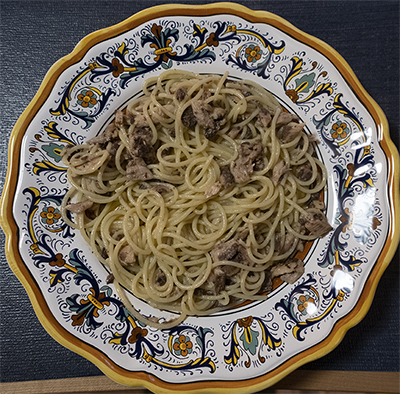la vigilia
December 24, 2022

pasta e sarde
…
As I’ve written many times, the menu and traditions of la vigilia di natale – Christmas Eve – have always been my favorite.
Christmas Day, at least for the immigrant communities of Ontario, has been usurped by the mythology of happiness through conspicuous consumption – propaganda the British and the American corporations have peddled for decades.
And as I wrote in a previous post, Italians in Italy have decided to take back la vigilia and celebrate their traditions and their foods on December 24. Because they too have succumbed to the conspicuous consumption of Christmas.
Food traditions brought over from Calabria
- pasta e sarde: Spaghetti with olive oil and anchovies – first course. Given that la vigilia was a fast-day and no meat was to be eaten, pasta had to be dressed with something other than red sauce. (Red sauce was always made with a meat stock and meat was not allowed on a fast-day.) Pasta e sarde was probably my second favorite item of the Christmas Eve menu. (The cullurielli with the anchovy were number one.) My aunt, my mother and I were the pasta e sarde eaters; the rest turned up their noses at this simple flavorful dish. The above image is a variation where I replaced the salty anchovy with less salty and more meaty sardines.
- pasta with a calamaro flavored red sauce: For the ‘next generation’ those not raised on pasta e sarde, and for those that hated pasta e sarde, my uncle made a red sauce flavored with calamaro – squid. (It was really good.) But NO!!! (I’ve been told I can be rigid on certain things, especially when I like a particular food. Let me tell you about sambuca served COLD – OMG are you for real? First, it clouds, so you lose the beautiful clearness. Second, cloudy sambuca is not attractive, and we know Italians are all about la bella figura – the look.)
- baccala: It’s dry, salted cod. HATED it. Baccala was the main dish of the second course. It was served in at least 3 different way – fried, battered and fried, and in a delicate red sauce. The Canadian immigrants who were rushing to assimilation began to add shrimp and other fishes to the menu, but they never removed the baccala. (Let me take a minute to rant about the feast-of-the-seven-fishes – I never heard of this until I moved to Western Pennsylvania and I’m convinced that it is a tradition of Western Pennsylvanian Italian immigrants who had enough money to add other fish dishes to the Christmas Eve menu. No one in Italy would know what you’re talking about if you asked about the feast-of-the-seven-fishes.)
- cullurielli-1: These are unleavened, potato based, deep-fried dough rings. (I’ve always wondered if their origin was with the Jews of Calabria. According to some sources, in the Middle Ages, some areas of Calabria may have had a Jewish population of up to fifty percent. After all, there is no proscription in Catholicism against leavened bread on a fast-day, and Christmas Eve was very much a fast-day, so why have an unleavened bread-like item?)
- cullurielli-2: These are first made for the feast of the Immaculate Conception – December 8 – and in my family brought back for the weeks before and after Christmas. On Christmas Eve they took the place of bread. My favorite variation of cullurielli are the ones with an anchovy in the middle. It was always a feat to find the ones with the salty fish, because they had been made in the early part of the month, then frozen and brought back for the Christmas season; by then my mother had forgotten which were which. (My parents’ cullurielli were the best – this was the consensus of the extended family that included the Mutos, the McCaigs, the Melchiorres and the Thormans.)
- bitter vegetables – rapini & broccoli: Eating rapini with an anchovy filled cullurielli is heaven. I still eat rapini on a regular basis; I only blanch them, add hot Calabrian spices but no cullurielli. Orecchiette pasta with sausage and rapini is a home-run.
- salad
- dessert – fennel, tangerines and espresso (espresso with sambuca – caffè corretto): After the pasta e sarde, the rapini, cullurielli and the salad, I would reach for the fennel – it soothed my salt saturated stomach. And let me post a second peeve – espresso is the elixir of the southern Mediterranean shores; sambuca is the liqueur of the gods. Whoever decided to mix them should have their taste buds singed. Espresso polluted by a second flavor is a sin. I’m just going to leave it there.